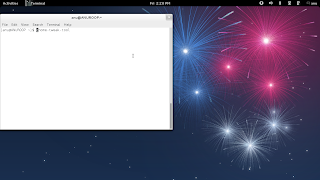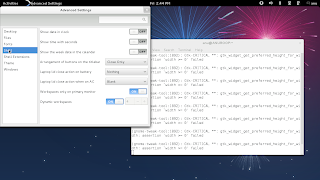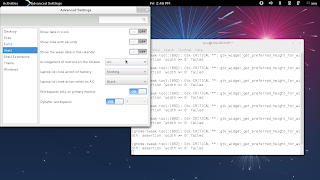ntroduction
Ansible is an easy configuration management system that can be used to automate and organize your system configuration tasks for a large network of computers. While some other configuration management systems require many different packages to be installed on the server and client systems, with Ansible, you only need to install a server component and have SSH access to the client machines.In a previous guide, we discussed how to install the Ansible software and learn basic commands. In this guide, we will discuss Ansible playbooks, which are Ansible's way of creating automated scripts to configure client computers.
We will assume that you have a configured Ansible server and a few clients, just as we left off in the last tutorial. In our guide, the server is a Ubuntu 12.04 machine, and the clients that we are going to be configuring are also Ubuntu 12.04 machines, for ease of explanation.
What are Ansible Playbooks?
Ansible playbooks are a way to send commands to remote computers in a scripted way. Instead of using Ansible commands individually to remotely configure computers from the command line, you can configure entire complex environments by passing a script to one or more systems.Ansible playbooks are written in the YAML data serialization format. If you don't know what a data serialization format is, think of it as a way to translate a programmatic data structure (lists, arrays, dictionaries, etc) into a format that can be easily stored to disk. The file can then be used to recreate the structure at a later point. JSON is another popular data serialization format, but YAML is much easier to read.
Each playbook contains one or more plays, which map hosts to a certain function. Ansible does this through something called tasks, which are basically module calls.
Exploring a Basic Playbook
Let's look at a basic playbook:---
- hosts: droplets
tasks:
- name: Installs nginx web server
apt: pkg=nginx state=installed update_cache=true
notify:
- start nginx
handlers:
- name: start nginx
service: name=nginx state=started
The file starts with:
---
---, but Ansible only wants one per file, so this should only be present at the top of the file.YAML is very sensitive to white-space, and uses that to group different pieces of information together. You should use only spaces and not tabs and you must use consistent spacing for your file to be read correctly. Items at the same level of indentation are considered sibling elements.
Items that begin with a
- are considered list items. Items that have the format of key: value operate as hashes or dictionaries. That's pretty much all there is to basic YAML.YAML documents basically define a hierarchical tree structure with the containing elements further to the left.
On the second line, we have this:
---
- hosts: droplets
Next, we have a set of tasks:
---
- hosts: droplets
tasks:
- name: Installs nginx web server
apt: pkg=nginx state=installed update_cache=true
notify:
- start nginx
The first one, "name", is more of a description than a name. You can call this whatever you would like.
The next key is "apt". This is a reference to an Ansible module, just like when we use the ansible command and type something like:
ansible -m apt -a 'whatever' all
update-cache=true part tells our remote machine to update its package cache (apt-get update) prior to installing the software.The "notify" item contains a list with one item, which is called "start nginx". This is not an internal Ansible command, it is a reference to a handler, which can perform certain functions when it is called from within a task. We will define the "start nginx" handler below.
---
- hosts: droplets
tasks:
- name: Installs nginx web server
apt: pkg=nginx state=installed update_cache=true
notify:
- start nginx
handlers:
- name: start nginx
service: name=nginx state=started
For instance, we have a handler here that starts the Nginx service after the package is installed. The handler is not called unless the "Installs nginx web server" task results in changes to the system, meaning that the package had to be installed and wasn't already there.
We can save this playbook into a file called something like "nginx.yml".
Just for some context, if you were to write this same file in JSON, it might look something like this:
[
{
"hosts": "droplets",
"tasks": [
{
"name": "Installs nginx web server",
"apt": "pkg=nginx state=installed update_cache=true",
"notify": [
"start nginx"
]
}
],
"handlers": [
{
"name": "start nginx",
"service": "name=nginx state=started"
}
]
}
]
Running an Ansible Playbook
Once you have a playbook built, you can call it easily using this format:ansible-playbook playbook.yml
For instance, if we wanted to install and start up Nginx on all of our droplets, we could issue this command:ansible-playbook nginx.yml
However, if we would like to filter the host list to only apply to one of those hosts, we can add a flag to specify a subset of the hosts in the file:
ansible-playbook -l host_subset playbook.ymlSo if we only wanted to install and run Nginx on our "host3", we could type this:
ansible-playbook -l host3 nginx.yml
Adding Features to the Playbook
Right now our playbook looks like this:---
- hosts: droplets
tasks:
- name: Installs nginx web server
apt: pkg=nginx state=installed update_cache=true
notify:
- start nginx
handlers:
- name: start nginx
service: name=nginx state=started
We can start to expand the functionality by adding tasks to our playbook.
Add a Default Index File
We can tell it to transfer a file from our Ansible server onto the host by adding some lines like this:---
- hosts: droplets
tasks:
- name: Installs nginx web server
apt: pkg=nginx state=installed update_cache=true
notify:
- start nginx
- name: Upload default index.html for host
copy: src=static_files/index.html dest=/usr/share/nginx/www/ mode=0644
handlers:
- name: start nginx
service: name=nginx state=started
We can then make a directory called static_files in our current directory and place an index.html file inside.mkdir static_files
nano static_files/index.html
<html>
<head>
<title>This is a sample page</title>
</head>
<body>
<h1>Here is a heading!</h1>
<p>Here is a regular paragraph. Wow!</p>
</body>
</html>
Now, when we re-run the playbook, Ansible will check each task. It will see that Nginx is already installed on the host, so it will leave it be. It will see the new task section and replace the default index.html file with the one from our server.
Registering Results
When you are installing and configuring services manually, it is almost always necessary to know whether your actions were successful or not. We can cook this functionality into our playbooks by using "register".For each task, we can optionally register its result (failure or success) in a variable that we can check later on.
When using this functionality, we also have to tell Ansible to ignore errors for that task, since normally it aborts the playbook execution for that host if any trouble happens.
So, if we want to check whether a task has failed or not to decide on subsequent steps, we can use the register functionality.
For instance, we could tell our playbook to upload an
index.php file if it exists. If that task fails, we could instead try to upload an index.html
file. We will check for the failure condition in the other task
because we only want to upload the HTML file if the PHP file fails:---
- hosts: droplets
tasks:
- name: Installs nginx web server
apt: pkg=nginx state=installed update_cache=true
notify:
- start nginx
- name: Upload default index.php for host
copy: src=static_files/index.php dest=/usr/share/nginx/www/ mode=0644
register: php
ignore_errors: True
- name: Remove index.html for host
command: rm /usr/share/nginx/www/index.html
when: php|success
- name: Upload default index.html for host
copy: src=static_files/index.html dest=/usr/share/nginx/www/ mode=0644
when: php|failed
handlers:
- name: start nginx
service: name=nginx state=started
Note: We have not configured our host to handle PHP
files at this time, so even if you did upload a PHP file, it would not
be processed correctly.This new version tries to upload a PHP index file to the host. It registers the success of the operation into a variable called "php".
If this operation was successful, the task to remove the index.html file is run next.
If the operation failed, the index.html file is uploaded instead.
Conclusion
Now, you should have a good handle on how to automate complex tasks using Ansible. This is a basic example of how you can begin to build your configuration library.Combining host and group definitions as we learned about in the first tutorial, and using available variables to fill in information, we can begin to put together complex computer systems that interact with each other. In a future article, we will discuss how to implement variables into our playbooks and create roles to help manage complex tasks.
courtesy : digitalocean.com




